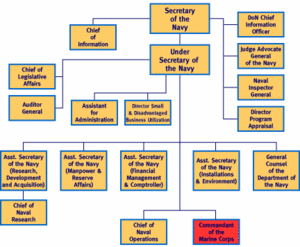Secretary of the Navy (U.S.)
The Secretary of the Navy (SecNav) is the civilian head of the Department of the Navy, which is part of the U.S. Department of Defense. Under the secretary are various civilian offices, and two military services, the United States Navy and United States Marine Corps. The professional heads of the services, respectively, are the Chief of Naval Operations (CNO), and the Commandant of the Marine Corps (CMC). Even though the CNO and CMC report to SecNav, none of the three currently have control over the operating forces of the United States Navy or United States Marine Corps.
Control over operating forces starts with the President and Secretary of Defense (SecDef), who direct the commanding officers of the Unified Combatant Commands (UCC). The UCCs, which have components from all the military services and have either a geographic (e.g., Pacific, Central) or functional (e.g., Special Operations, Transportation) responsibility. Jointly, the President and SecDef form the National Command Authority.
History
The Department of the Navy was created in 1798, with its own secretary. Nine years earlier Congress created the War Department, headed by the Secretary of War, which handled naval affairs. As a result of the National Security Act of 1947, as amended, the Navy department was merged into the "National Military Establishment," which was renamed the Department of Defense in 1949. SecNav then began to report to the Secretary of Defense (SecDef). Both the SecDef and SecNav are appointed by the President and confirmed by the Senate, and serve at the pleasure of the President.
It is the responsibility of the Secretary, his civilian deputies (who may have uniformed direct reports), and the CNO and CMC to prepare the forces for operational deployment under the UCCs.
The Secretary of the Navy (SECNAV) is responsible for, and has the authority under Title 10 of the United States Code, to conduct all the affairs of the Department of the Navy, including: recruiting, organizing, supplying, equipping, training, mobilizing, and demobilizing. The Secretary also oversees the construction, outfitting, and repair of naval ships, equipment and facilities. SECNAV is responsible for the formulation and implementation of policies and programs that are consistent with the national security policies and objectives established by the President and the Secretary of Defense. The Department of the Navy consists of two uniformed Services: the United States Navy and the United States Marine Corps.
The Secretaries of the Army and Air Force have similar responsibilities to prepare the force. The Marine Corps is a branch of the U.S. Navy.
Donald C. Winter was the 74th Secretary of the Navy, sworn into office on January 3, 2006. His background was in engineering management with little Pentagon experience. At his confirmation, he repeatedly told Congress he knew little about the major issues facing the Navy. President Obama and Secretary of Defense Robert Gates asked him to remain at the end of the George W. Bush Administration and to hold the job until a new nominee was confirmed, which he did.
President Obama nominated former Mississippi governor Ray Mabus to be Winter's replacement and was sworn in June 18, 2009.[1]
References
- ↑ Foon Rhee (March 27, 2009), "Obama taps former Miss. governor for Navy slot", Boston Globe
